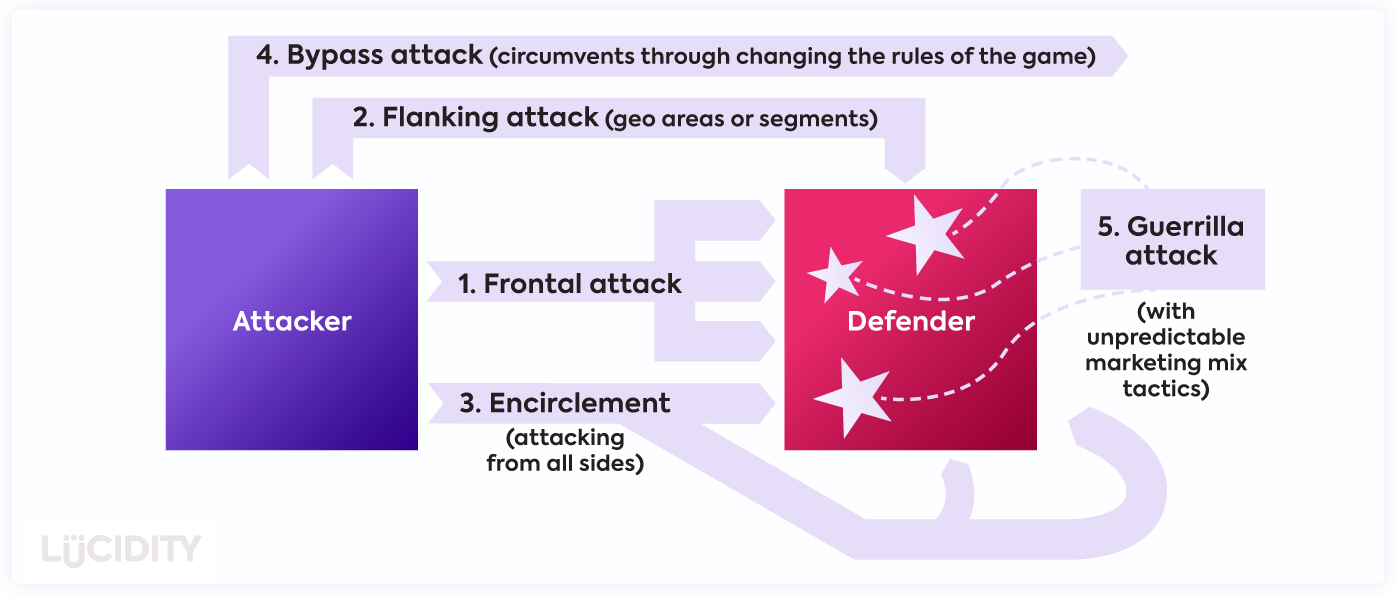Attack strategies, otherwise known as market challenger strategies or offensive competitive strategies, are a collection of approaches to taking on a competitor in a marketplace. There are many ways attack strategies can manifest so let’s take a look at some common forms.
What are Attack Strategies?
Attack Strategies are proactive and aggressive approaches taken against a particular competitor to achieve market dominance. Often the competitor being challenged is the market leader and the company doing the attacking is a looking to take market share from them. Attack Strategies are usually led by Marketing teams and regarded as a type of marketing strategy.
These strategies are all about understanding the strengths and weaknesses of the competitor business, targeting a particular aspect or aspects of their offering and proactively attacking it either in a direct way or less direct way.
What are the types of Attack Strategy?
There are a number of different attack strategies you can employ to challenge the competition. Which strategy you pick will depend on the strengths and weakness of your own business, product or service, the fire-power you have (in terms of money and resources) and the particular strengths and weaknesses of the competitor you are targeting.
There are five types of attack strategy:
– Frontal Attack Strategy
– Flanking Attack Strategy
– Encirclement Attack Strategy
– Bypass Attack Strategy
– Guerrilla Attack Strategy
Each of these strategies has it’s own advantages and disadvantages, and choosing which one is right for your business and your ambitions will take some careful consideration. With that in mind, we’ve pulled together this Ultimate Guide to Attack Strategies to give you the full lowdown on each and every option so you can fully understand what circumstances are best suited to what attack strategy.
What do I need to know about Frontal Attack Strategies?
A Frontal Attack Strategy is all about taking on a competitor in a market head-on. This is the most direct and full force of all the attack strategies. There is nothing stealth or covert about this approach – you are going all guns blazing into battle here.
Commonly this attack strategy is best suited and utilized most by larger businesses with considerable fire power. So if you’re a big business looking to dominate in a new market or establish undisputed market dominance, then this may well be the strategy for you.
There are actually three types of Frontal Attack Strategy for you to understand and consider. You can find out more in our Frontal Attack Strategy Guide.
What do I need to know about Flanking Attack Strategies?
A flanking attack is when you take a competitor on in their perceived weak spot. Here you are targeting the areas where the competitor is vulnerable. That might be a particular product, a geography, a customer segment – any aspect of their business where they are potentially less focused.
A flanking attack allows you to be really focused and put all your efforts into one particular area. You can find out more in our Flanking Attack Strategy Guide.
What do I need to know about Encirclement Attack Strategies?
With an Encirclement Attack Strategy you are surrounding a competitor and attacking from all sides in order to take market dominance. This strategy requires you to attack both the strengths and the weaknesses of your competitor at the same time. So it’s a pretty resource-heavy and demanding approach to take, but it does, potentially, increase your chances of success. By targeting all aspects you’re increasing the likelihood that one particular angle will prove successful and push you ahead of the competitor.
You can find out more in our Encirclement Attack Strategy Guide.
What do I need to know about Bypass Attack Strategies?
Sometimes going round a competitor is the best route, such as creating a new product that displaces their original one. This particular attack strategy has been deployed to great effect by smaller companies looking to take on very large, very dominant competitors. It’s a completely different approach to the Frontal Attack Strategy and the antithesis of competing head-on.
You can find out more in our Bypass Attack Strategy Guide.
What do I need to know about Guerrilla Attack Strategies?
A Guerrilla Attack Strategy focuses on a series of small, random attacks on a competitor in order to disorientate them. Guerrilla attacks, due to their unpredictable and frequent nature, can prove extremely hard to respond to for the company under attack.
This attack strategy is often used by smaller challenger companies without the same level of resource or budget as their larger competitors. It’s probably the most fun attack strategy with real opportunity for creative campaigning.
You can find out more in our Guerrilla Attack Strategy Guide.
Do companies use just one Attack Strategy?
No, rarely is this the case. Academically, the different approaches used to attack competitors can fit nicely into these five strategies, but, in reality, it is usually the case that companies take each other on using a mix of these different approaches. The only exception is perhaps Bypass, as this is usually tied into diversification and an intent to change a market.
Who uses Attack Strategies?
Market attack strategies are normally deployed against the market leader by new entrants or those with less market share. Of course this isn’t always the case, there are many examples of market leaders attacking smaller rivals.
Although Attack Strategies are often regarded as marketing strategies, setting your attack strategy often involves some cross-functional decision making. The marketing team will always be heavily involved in the implementation and execution of your chosen attack strategy, but depending on which strategy you adopt, other departments will also need to play a significant part. That could be the product team if it’s decided that a Bypass Attack Strategy would give the best chances of success, or the HR team if you’re undertaking a Flanking Attack and looking to establish your operations in a new geography.
What is the difference between strategic position and your chosen attack strategy?
The term ‘strategy’ is used often to describe different things, so this can be confusing. If you look at tools like Generic Strategies or Bowman’s Strategy Clock, you see a series of different positions you can take in a market. Low cost, differentiation, etc.
These are strategies you can take when entering a market. To complement this, you may also decide upon an attack strategy which describes how you take on a competitor. For example, you may decide to position yourself as lowest cost but deploy a series of marketing campaigns highlighting the difference in cost and value against a competitor. This could be a mix of Low Cost & Guerrilla Attack.
So the two types of strategy – position and approach – are not mutually exclusive.
So there you have it….
That’s everything you need to know to understand each of the different strategies for taking on a competitor and winning market share. Each of our guides into the different attack strategies will help you see what each approach involves, what tactics are employed, when it’s best to use them and some examples of businesses who have used that strategy to take on a competitor.
Armed with this knowledge and understanding you should be able to make a well-informed decision about how you’ll go after market share and grow your business. Good luck!
Build & Execute Your Attack Strategy in Lucidity
Book a personal demo and we'll show you all the tools you'll need to help your decision making, build out your plan and manage the execution.












